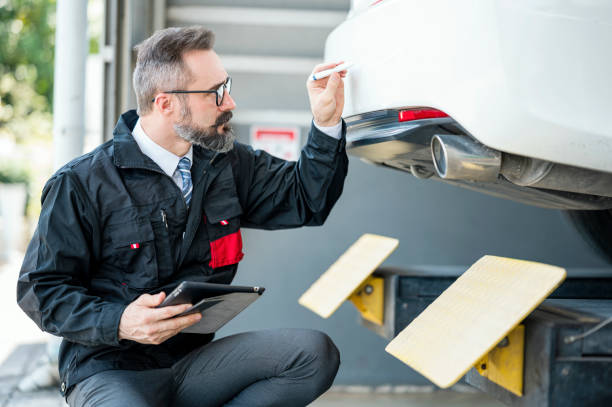Car insurance coverage refers to the various protections offered by an auto insurance policy to help cover financial losses from accidents, theft, or other vehicle-related incidents.
Car insurance protects you financially when accidents happen. Understanding different coverage types helps you choose the right protection for your needs.
Most states require minimum liability coverage. However, basic coverage may not protect you from all financial risks.
This guide explains each coverage type clearly. You’ll learn what each covers and why it matters.
Understanding Car Insurance Basics
Car insurance is a contract between you and an insurance company. You pay premiums, and they cover certain losses.
Insurance companies assess risk factors to determine your rates. These include your driving record, age, and location.
Coverage limits determine how much your insurer pays. Higher limits mean better protection but cost more.
Mandatory vs. Optional Coverage Types
Required Coverage
Most states mandate certain coverage types. Liability insurance is required in nearly all states.

Some states require personal injury protection (PIP). Others mandate uninsured motorist coverage.
Check your state’s requirements before purchasing a policy. Driving without required coverage is illegal.
Optional Coverage
Optional coverages provide additional protection. These include comprehensive, collision, and gap insurance.
While not legally required, lenders often mandate certain coverages. This protects their financial interest in financed vehicles.
Consider your financial situation when choosing optional coverages. They can prevent significant out-of-pocket expenses.
Liability Insurance: Your Legal Responsibility
Bodily Injury Liability
Bodily injury liability covers injuries to others in accidents you cause. This includes medical expenses and lost wages.
It also covers legal fees if you’re sued. Without adequate coverage, you could face personal financial ruin.
Most experts recommend higher limits than state minimums. Consider at least $100,000 per person and $300,000 per accident.
Property Damage Liability
Property damage liability covers damage to others’ property. This includes vehicles, buildings, and personal belongings.
It doesn’t cover your own vehicle damage. You need separate coverage for your car’s repairs.
Minimum limits vary by state. However, repair costs often exceed these minimums significantly.
Comprehensive Coverage: Protection Beyond Collisions
Comprehensive coverage protects against non-collision damages. This includes theft, vandalism, and weather-related damage.
Natural disasters like floods and hurricanes are covered. So are animal collisions and falling objects.
This coverage typically includes a deductible. Higher deductibles mean lower premiums but more out-of-pocket costs.
What Comprehensive Covers
Theft and attempted theft
Vandalism and malicious mischief
Natural disasters (floods, hurricanes, earthquakes)
Fire damage
Falling objects (trees, rocks, hail)
Animal collisions
Civil disturbances and riots
When to Consider Comprehensive
Comprehensive makes sense for newer, valuable vehicles. It’s also wise in areas prone to natural disasters.
If your car’s value is low, comprehensive might not be cost-effective. Compare the coverage cost to potential payouts.
Lenders typically require comprehensive coverage on financed vehicles. This protects their collateral investment.
Collision Coverage: When Accidents Happen
Collision coverage pays for your vehicle’s damage in crashes. This applies regardless of who’s at fault.
It covers collisions with other vehicles and stationary objects. Single-car accidents are also included.
Like comprehensive, collision coverage includes a deductible. Choose a deductible you can afford to pay.
Collision vs. Comprehensive
Collision covers crash-related damage only. Comprehensive covers nearly everything else.
Both coverages are optional unless required by lenders. Many drivers choose both for complete protection.
Consider your vehicle’s value when deciding. Older cars might not justify the expense.
Personal Injury Protection (PIP): Medical Coverage
PIP covers medical expenses regardless of fault. It also covers lost wages and essential services.
Some states require PIP coverage. Others offer it as an optional add-on.
PIP typically covers a percentage of expenses. Coverage limits vary by state and policy.
PIP Benefits
Medical expenses for you and passengers
Lost wages (usually 60-80% of income)
Essential services (childcare, housekeeping)
Rehabilitation costs
Death benefits in some states
Uninsured/Underinsured Motorist Coverage
This coverage protects you from uninsured drivers. It also covers situations where other drivers have insufficient insurance.
Hit-and-run accidents are typically covered. So are accidents with drivers whose insurers deny claims.
Coverage includes both bodily injury and property damage. Some states require one or both types.
Why This Coverage Matters
Approximately 13% of drivers are uninsured nationally. In some states, this percentage is much higher.
Even insured drivers may carry minimum limits. These limits might not cover your full damages.
This coverage is often inexpensive relative to protection provided. Consider purchasing limits matching your liability coverage.
Medical Payments Coverage (MedPay)
MedPay covers medical expenses for you and passengers. It applies regardless of who caused the accident.
Unlike PIP, MedPay doesn’t cover lost wages. It focuses solely on medical expenses.
This coverage complements health insurance. It often covers deductibles and copayments.
MedPay vs. PIP
PIP provides broader coverage including lost wages. MedPay is typically less expensive but more limited.
Some states offer both options. Others require PIP instead of MedPay.
Consider your health insurance coverage when choosing. Good health insurance might reduce MedPay’s value.
Gap Insurance: Protecting Your Investment
Gap insurance covers the difference between your car’s value and loan balance. This matters when you owe more than the car is worth.
New cars depreciate rapidly in their first years. You might owe more than the car’s worth for several years.
If your car is totaled, standard insurance pays actual cash value. Gap insurance covers the remaining loan balance.
When Gap Insurance Makes Sense
When You made a small down payment
You have a long loan term
Then you bought a rapidly depreciating vehicle
You rolled negative equity into a new loan
Rental Car Coverage
Rental car coverage pays for temporary transportation. This applies when your car is being repaired after a covered claim.
Coverage typically includes daily and total limits. Exceed these limits, and you pay the difference.
Some credit cards provide rental car coverage. Check your benefits before purchasing duplicate coverage.
Roadside Assistance Coverage
Roadside assistance provides help when your car breaks down. Services include towing, jump-starts, and lockout assistance.

Coverage is typically inexpensive but very convenient. It provides peace of mind for unexpected breakdowns.
Many companies offer 24/7 service nationwide. Response times vary by location and demand.
Common Roadside Services
Towing to nearest repair facility
Battery jump-start service
Flat tire changing
Lockout assistance
Emergency fuel delivery
Winching service
How Different Coverages Work Together
Car insurance works best when coverages complement each other. Each type addresses specific risks and scenarios.
Liability protects others and meets legal requirements. Comprehensive and collision protect your vehicle.
Medical coverages protect you and passengers. Uninsured motorist coverage fills gaps in others’ insurance.
Creating a Balanced Policy
Start with required coverages at appropriate limits. Add comprehensive and collision for newer vehicles.
Consider your assets when choosing liability limits. Higher-net-worth individuals need more protection.
Evaluate optional coverages based on your situation. Rural drivers might prioritize roadside assistance.
Factors Affecting Coverage Costs
Several factors influence your insurance premiums. Understanding these helps you make informed decisions.
Your driving record significantly impacts rates. Clean records earn discounts and lower premiums.
Vehicle type affects costs dramatically. Sports cars and luxury vehicles cost more to insure.
Major Cost Factors
Driving record and experience
Age and gender
Location and zip code
Vehicle make, model, and age
Annual mileage
Credit score (where permitted)
Coverage limits and deductibles
Tips for Choosing the Right Coverage
Assess your financial situation honestly. Consider what you could afford to pay out-of-pocket.
Review your coverage annually or after major life changes. Marriage, moving, or buying a home affects insurance needs.
Don’t choose coverage based solely on price. The cheapest option might leave you financially vulnerable.
Just as you would carefully consider homeowners insurance options, research car insurance thoroughly. Like researching life insurance agents, ask detailed questions about coverage.
Smart Shopping Strategies
Compare quotes from multiple insurers
Ask about available discounts
Consider bundling policies for savings
Review coverage limits regularly
Maintain continuous coverage
Consider higher deductibles for lower premiums
When comparing options, use resources like life insurance quote comparison tools for guidance on evaluation methods.
State-Specific Requirements
Insurance requirements vary significantly by state. Some states require only liability coverage.
No-fault states mandate PIP coverage. Others require uninsured motorist protection.
Research your state’s specific requirements carefully. Failing to meet minimums can result in penalties.
Common State Variations
- Minimum liability limits
- PIP or MedPay requirements
- Uninsured motorist mandates
- Proof of insurance rules
- Penalties for driving uninsured
Making Claims: How Coverage Responds
Understanding the claims process helps you use coverage effectively. Different coverage types have different procedures.
Contact your insurer immediately after accidents. Provide accurate, detailed information about what happened.
Document everything thoroughly including photos and witness information. This supports your claim and speeds processing.
Claims Process Steps
Report the incident immediately
Provide necessary documentation
Cooperate with the investigation
Get repair estimates if required
Review settlement offers carefully
Keep records of all communications
Common Coverage Mistakes to Avoid
Many drivers make costly coverage mistakes. Understanding these helps you avoid financial problems.
Choosing minimum coverage saves money initially. However, it often provides inadequate protection.
Failing to update coverage after life changes creates gaps. Review your policy when circumstances change.
Frequent Mistakes
Carrying insufficient liability limits
Skipping uninsured motorist coverage
Not updating coverage after vehicle changes
Choosing deductibles too high to afford
Letting coverage lapse to save money
Not understanding policy exclusions
Future of Car Insurance Coverage
Technology is changing car insurance rapidly. Usage-based insurance tracks driving habits for personalized rates.

Autonomous vehicles will eventually change coverage needs. The transition period will require careful consideration.
Electric vehicles have different risks and costs. Insurance companies are adapting coverage accordingly.
Similar to how homeowners insurance evolves with new risks, car insurance continues adapting to technological changes.
Conclusion
Understanding car insurance coverage types empowers better decision-making. Each coverage serves specific purposes and protects against different risks.
Start with required coverages at adequate limits. Add optional coverages based on your specific situation and risk tolerance.
Review your coverage regularly and shop around periodically. The insurance market changes constantly, and better deals might be available.
Remember that the cheapest coverage isn’t always the best value. Balance cost with protection to ensure adequate financial security.
Frequently Asked Questions (FAQs)
Q: What’s the minimum car insurance required in most states? A: Most states require liability insurance covering bodily injury and property damage. Minimum limits vary by state, typically ranging from $15,000 to $50,000 per person for bodily injury.
Q: Do I need comprehensive and collision coverage? A: These coverages aren’t legally required but may be mandatory if you finance or lease your vehicle. They’re recommended for newer or valuable cars.
Q: What’s the difference between PIP and medical payments coverage? A: PIP covers medical expenses plus lost wages and essential services. Medical payments coverage only covers medical expenses but is typically less expensive.
Q: How much liability coverage should I carry? A: Experts recommend at least $100,000 per person and $300,000 per accident for bodily injury, plus $100,000 for property damage. Consider higher limits if you have significant assets.
Q: When should I consider dropping comprehensive and collision coverage? A: Consider dropping these coverages when your vehicle’s value is low enough that the annual premium cost approaches the potential payout amount.
Q: What factors affect my car insurance rates most? A: Your driving record, age, location, vehicle type, and credit score (where permitted) are the primary factors affecting insurance rates.
Q: How often should I review my car insurance coverage? A: Review your coverage annually and after major life changes like moving, getting married, buying a new car, or significant changes in income.
Q: What’s gap insurance and do I need it? A: Gap insurance covers the difference between your car’s actual value and what you owe on your loan. It’s beneficial for new cars or when you have a small down payment.
3 thoughts on “What Are the Different Types of Car Insurance Coverage?”